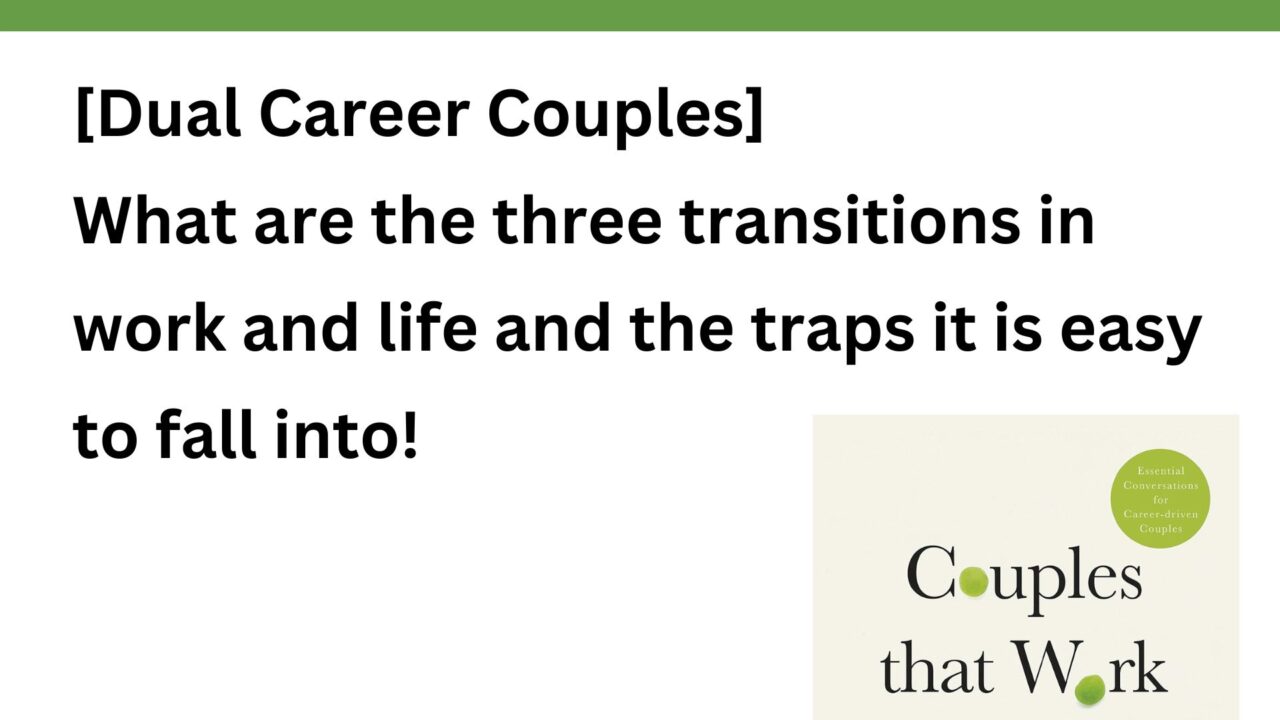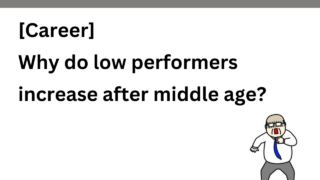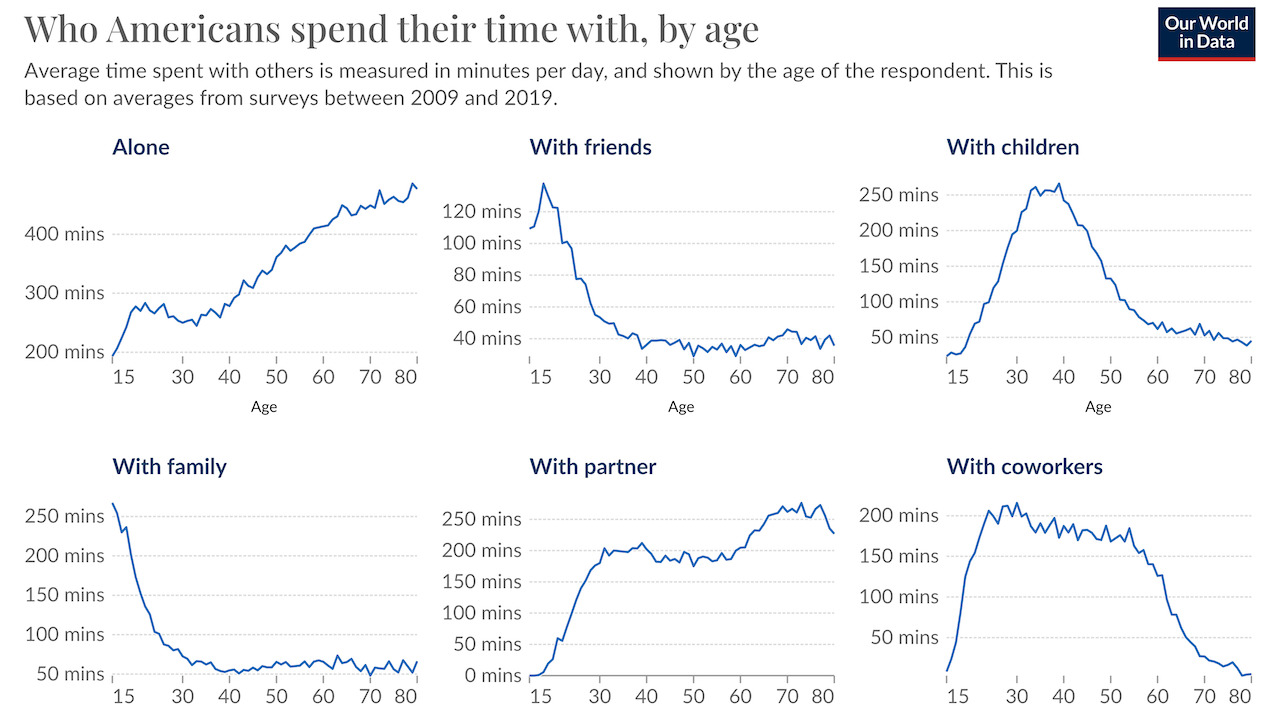Introduction.
INSEAD associate professor surveyed 113 couples (including same-sex couples, de facto marriages, and remarriages) from 32 countries, including Japan, between the ages of 26 and 63. Child rearing, relocation, career change, caregiving, retirement, and child independence. ……
In the age of 100 years of life, this book explains the three turning points that stand in the way of two career-oriented people and how to overcome them.
The book takes a long-term and comprehensive view of the life stages that will eventually come, such as life changes after having children, caring for parents, and mid-life crisis, which until now we have only vaguely recognized as life stages that will come sooner or later. The book is also, as is often the case with American books, quite rich in case studies.
I would like to summarize the three main turning points for dual career couples.
First transition period (20s-30s): adjustment to the birth of a child
First, they are forced to figure out how to adapt to the first big event in their lives that they will experience together as a couple. Those big events are twofold.
- Great opportunities on the job: promotions or layoffs that would require geographic relocation
- Birth of a child
When a person is in his or her 20s and has not yet had children, he or she is at a stage where he or she can devote himself or herself completely to his or her career and is not yet constrained by life events such as mortgages or caring for parents, which have not yet occurred. In this book, this stage is called “unconstrained deviance.
This is a time when the values that one partner blindly believed in when they were in their twenties- “We can have everything we want, work and family “-must be confronted with reality. The reality is that the values that we blindly believed in our twenties, that we could have everything we wanted in life, including a job and a family, are not realistic at all.
Hook-and-loop trap: Over-reliance on economic criteria
Now, the first trap that couples in the first transition often fall into is described as “relying too much on economic criteria.
Choices to maximize income, choose where to live, choose which career to prioritize, and choose which one will be the primary caretaker of the children seem reasonable, but they are not. It is because it devalues the values and desires of the couple involved over their financial needs.
If income maximization is the only criterion for decision-making, it is easy to conclude that one of the partners will temporarily suspend their career, and since this will essentially open up the income between the partners, they will be forced to make decisions based more, and more on economic rationality, forcing one of them to endure more and more. And in the long run, the couple’s relationship is more likely to break down.
In layman’s terms, this book tells us that both should work hard, not one horsepower, but two, without interrupting their careers.
On average, 31 percent of mothers leave their careers to care for their children. The median length of time away from work is two years. While some women leave their careers out of a sincere desire to focus on their families, many women leave their jobs for a period of time out of a sense of obligation and later regret their choice and the consequences.
The tipping point may come when calculating the ratio of childcare costs to income. “I’m taking most of my salary for childcare, and I’m starting to think, ‘Why bother working at all?'” is a common refrain we hear when studying women who leave the workforce. This is a common observation among women who leave the workforce.
Women who have been out of work for more than three years face a 37 percent loss of income when they return to work. While infancy seems an awfully long time when one is in the midst of raising a child, it is a small percentage of one’s overall 40-plus year career. On the other hand, studies have calculated that the total financial loss from leaving the workforce is more than $1 million over a lifetime.
Dual Career Couple] Overcoming Three Transitions in Work and Life through Dialogue
Division of household chores: visualizing the list and deciding what not to do
The book also mentions the division of household chores.
Both men and women overestimate the share of household chores they undertake. Women believe they are doing the majority of the work, while men believe they are taking on 50%.
In reality, however, some surveys show that on average, men devote 16 hours per week and women 26 hours per week to housework. In this case, male: female = 40:60.
This discrepancy in perception occurs simply because they do not know what chores their partners are doing.
therefore
- Visualize by writing out a list of chore assignments.
- Instead of starting assignments as soon as you write out your list, before you do so, ask yourself, “Which ones can I stop?” before you start dividing up the work. If something can be outsourced or can be solved with technology, be proactive and incorporate it. In some cases, we do things just because the community expects it (or assumes it should be done) (e.g., do we always have to display a homemade cake at every school bazaar?)
In addition, the amount of time and energy that parents devote to their children has increased dramatically over the past 15 years, with both fathers and mothers spending more time with their children than in the 1990s.
He explains that it is not only because society expects it of him, but also because he himself does not want to miss out on his own child’s childhood.
The birth rate is lower now than in the past, and people are more conscious of the need to take better care of each child and/or to raise a child more perfectly, which may make it impossible to raise a child as “moderately loosely” as in the past.
In his book, he writes that both sides of the career should not give up or interrupt each other and that both parenting and career should be a two-horse effort, he explains the importance of having a dialogue with each other (insecurities, values, limitations, etc.) in order to achieve this. It is important to set clear and firm limits in advance and not fall into the trap of trying to “do it all. Perfectionism tends to create a sense of guilt, which leads to a vicious cycle, so it is also necessary to be able to say, “I can’t do anymore, so I’ll just have the kids’ meals delivered today.
Second turning point (40s): mutual individualization and midlife crisis
Now, even for couples who successfully overcome the first transition, the second transition (mid-life crisis) comes about 10 years later.
This is the “first sign that the ‘true self’ is about to pull away from the persona that has been developed to fit society’s expectations,” also known as the “second adolescence.
At this time, the children are now in upper elementary and junior high school, and although puberty is coming, they have moved on from the handful of times when they were small at the first transitional stage.
Even if you have been implicitly riding the rails of the expectations of those around you and the expectations of life, and have been steadily advancing within your company, you suddenly find yourself asking, “Was the job I’m doing now what I wanted to do?” and start to wonder, “Was the work I’m doing now what I wanted to do?
At this time, in Japan, one might become a section manager in one’s 40s and begin to see what the future holds if one continues working at the same company. You start to realize whether or not you will be able to move up to a managerial position, and you start to wonder, “Is it really worth it to continue working the same job for another 20 years? On the other hand, if they decide to start their own business, it will be difficult for them to take the plunge because it is the most expensive time of the year for their children’s education.
Children want options that are less stressful for their parents.
In one study, when children were asked how they would change their parents’ jobs if they could, the majority said they would like to make their parents’ jobs less stressful.
The children did not care what either parent did or how many hours they worked. What they cared about was the stress their parents were feeling and the effect it was having on them.
The transition to an individualized life path inevitably involves children and is somewhat stressful for them at first. In the long run, however, the stress will be lessened and the children will be happier as they are both more fulfilled. The children will accept the change in their families and will be less concerned about what the world thinks of them.
Dual Career Couple] Overcoming Three Transitions in Work and Life through Dialogue
What I can say from this is that there is no need to overthink (or assume) one’s children when it comes to one’s career choices. By this time, your children are already in middle school or so, and they already know better.
If something comes up that I would like to do away from my current firm, I would share it with my partner, and he or she would take an active interest in the option, but not interfere too much, and we would be able to successfully navigate this second transition period.
Third Turning Point (50s+): Identity Blank
Even if the second turning point is overcome, a third turning point will come in another 10 years or so.
This is the stage when they are in their fifties, sixties, or older, and are looking toward retirement.
Also, the child is already a college student and independent, and they are back to living together again.
In this life stage, they will face physical limitations and health problems, but what is different from the past is that the average life expectancy and healthy life expectancy have also increased, so they will remain in good health for another 20 years, assuming that they are 75-80 years old, until their bodies are truly rattled and it becomes difficult to move.
He will preach about how to live for about 20 years, from ages 55-75 and 60-80 or so, including after retirement. Especially for those who have worked hard and dedicated themselves to their work, they will suffer from a void of identity upon retirement.
The trap of being addicted: too much emphasis on work and child-rearing, and divorce at a ripe old age.
The trap that is easy to fall into here is that, as we will talk about before the third turning point, people gradually neglect taking care of each other as they take care of both work and child-rearing (which is inevitable to some extent), and as a result of not taking time to do so, after the children leave the nest, they end up divorcing at a ripe old age.
Even in between difficult times in their work careers and parenting, they need to actively make time to discuss their relationship.
As previously mentioned in the article “[Life] Who to Spend Time with as You Age: Alone Time Monotonically Increases from Age 40,” the amount of time that children spend with their parents does not begin to decline at age 20 (adulthood), but rather rapidly from age 15, and in inverse proportion to that, the amount of time spent with their partners increases.
It is not too much to say that as of the third year of junior high school, they are practically mostly with their school friends, they spend little time with their parents, and they have become mentally independent (or rather, the parents have little say in what they do). Therefore, it would be a good idea to start actively taking time away from parenting from this point onward, and shift toward making time for the two of them.
Find a common hobby that you are passionate about.
It seems that couples who have built strong relationships over the years have common interests that they are passionate about.
Common interests should be something we can be passionate about together, something that has nothing to do with either our careers or our children.
It can be anything from playing in a band together, renovating and selling used houses, playing tennis, etc., and it can be something that has been going on for a long time or irregularly. The point is to create a time and space to work together based on the same interests and goals.
summary
My current stage is a time when I have overcome the first stage, and the second stage may be coming in the future.
Personally, regarding the second phase, I took the option to start my own business after completing my initial residency and before my child was born, so I felt that the second phase came before the first phase (although the overlapping period was difficult), and what I really want to do (0 to 1 manufacturing) has not changed over the last 10 years or so, and that is where I felt grateful to be able to devote as much time as possible to it.
The two of us don’t have any common interests at the moment, so we will have to start looking for them.





